7 Stunning Road Trips for Electric Vehicles
- Oops!Something went wrong.Please try again later.
This article originally appeared on Outside
The Ford F-150 Lightning, the electric version of Ford's super-popular pickup truck that came out last year, is my fantasy. I have a standard gas F-150 but with the Lightning, I could save hundreds of dollars' worth of gas every month. The only thing holding me back from purchasing this particular electric vehicle? Something known as range anxiety. I travel a lot and I'm not sure the Lightning's reported 320-mile battery range can handle the long miles I demand from my truck.
But the road-trip landscape is getting exponentially more EV-friendly every year. Several years ago, the average max range of an EV per charge was around 100 miles. Today that has more than doubled to 216 miles, according to the non-profit EV Database.
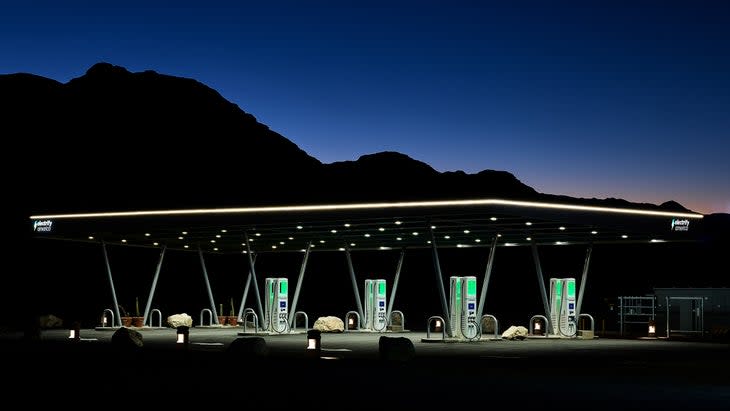
Even better news, the network of public charging stations is about to boom, with more than 51,000 already operating in the U.S., according to the Department of Energy. The federal government has allocated $7.5 billion to building more public EV chargers over the next several years to boost that number tenfold to 500,000 across the country by 2030.
In other words, it's getting easier all the time to take an EV road trip. Just ask Liv and Patrick Leigh, veterans of multiple 1,000+ mile adventures in their Ford Mustang Mach-E, documented on their blog, EV Explored. "We had a lot of anxiety heading out on our first EV road trip," Liv says. "But after several long trips and seeing friends crisscross the country in EVs, we know it can be done."
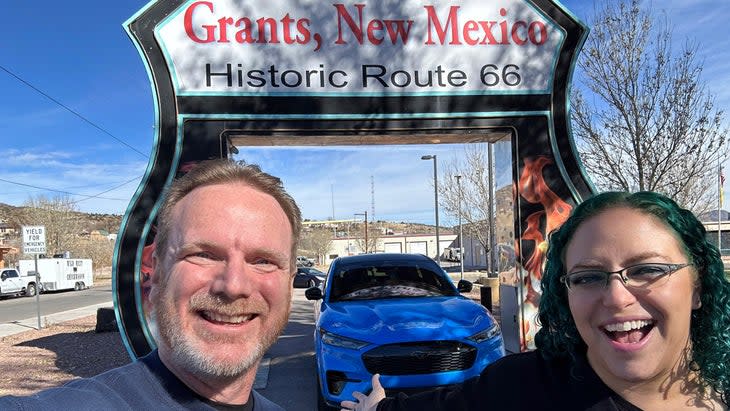
The key to a successful EV road trip, according to the Leighs, is to plan ahead, using apps like PlugShare or ChargeHub, which offer maps of every public charging station in the country and update you on their status, so you'll know in advance if one is broken or busy. That advice is worth repeating: Download an app with real-time data.
There are plenty of EV-friendly road trip options out there, and most major car rental agencies now offer electric vehicles you can try out if you're curious. In addition to gas savings and a lessened environmental impact, it's possible that EVs actually make the Great American Road Trip even better than ever.
"We’ve learned to enjoy road trips even more now that we are taking an EV," Patrick Leigh says. "Previously, in our gas car, road trips were all about getting to our destination as quickly as possible. ... Now the EV gives us an excuse to stop, stretch our legs, talk to people, and enjoy the journey."
I've mapped out seven scenic and adventurous road trips that you can pull off in an electric vehicle. Each starts from a large city, so you can rent an EV if you don't have one, and all of them make the most of the burgeoning public charging network, which I’ve noted for each below. Maybe someday you'll see me out there in that Lightning.
1. The Classic Desert Road Trip: Las Vegas to Grand Canyon National Park
Length: 350 miles
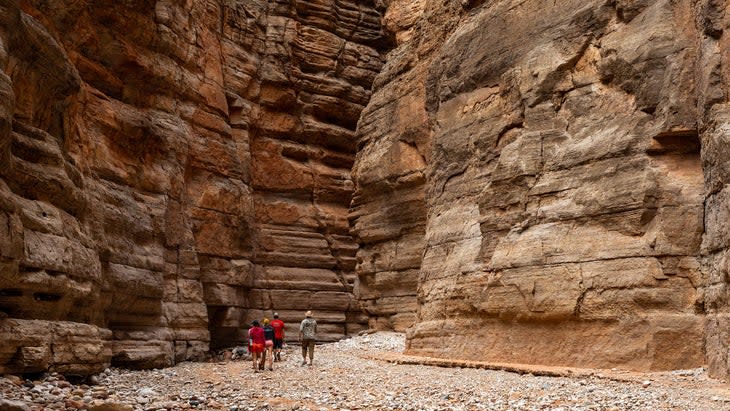
Driving from Vegas to the Grand Canyon is about as iconic a road trip as you can get. With copious DC Fast Chargers along the southern route, including a brand-new one installed by Electrify America near the South Rim of the Grand Canyon, this classic route is an ideal option for EVs.
Day 1: Las Vegas to Flagstaff, Arizona
253 miles
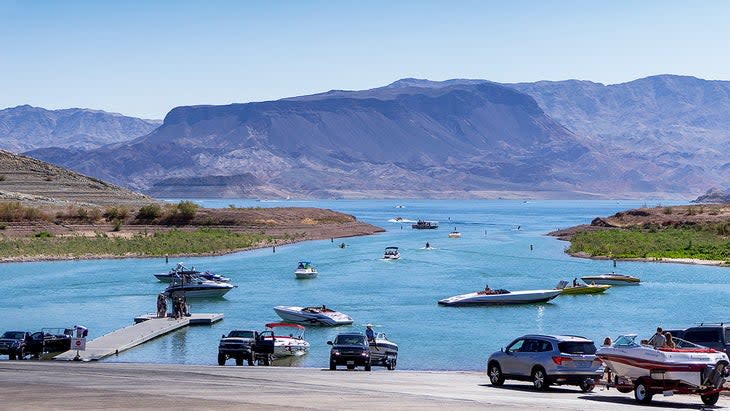
This is a big-mileage day to get you out of Vegas and closer to the Grand Canyon, but there are some potential adventure stops along the way. Las Vegas is loaded with DC fast chargers, so juice up here. Then head south on Highway 93, crossing over the Colorado River below Lake Mead and the Hoover Dam as you enter Arizona. If it's hot and you feel like taking a dip, head to Kingman Wash Beach, on the Arizona side of Lake Mead. Or keep heading south and hike the easy trail to Arizona Hot Spring, which is just a quick detour away. There's a fast charger at the Kroger grocery store in the town of Kingman, about 100 miles into the trip, if you want to top off.
Your destination for the night is Flagstaff, Arizona, where High Country Motor Lodge has a mix of inn rooms and cottages surrounding communal outdoor space with fire pits, tables, and lawn games, also a sauna and plunge pool (from $114 a night). You can charge your car at the DC Fast charger at the Walmart off Route 66.
Day 2: Flagstaff to Grand Canyon National Park
80 miles
Head north from Flagstaff for 80 miles on Highway 180 and Highway 64 to the South Rim of the Grand Canyon. There's a hyper fast DC charger at the Grand Canyon Visitor Center in the Grand Canyon Village. If it's your first time visiting the Grand Canyon, you're obligated to hike the Bright Angel Trail, which descends from the lip of the canyon to the Colorado River in 9.5 miles of switchbacks, dropping 4,500 feet in elevation. Most people don't hike the whole trail, though, so consider an 11-mile out-and-back to Plateau Point, passing through wild gardens and petroglyphs before ending at the outcropping that gives the hike its name, with impressive views of the Colorado River and sandstone canyon walls.
2. The Island-Hopping Road Trip: Miami to Key West
170 miles
Much of the South is an EV-charging-station desert, but Florida is an outlier, with more than 2,500 public charging stations, the third-most of any state in the country. A lot of those stations are located in South Florida, making this fun, beach-centric road trip from Miami to the southern tip of America an EV breeze.
Tesla drivers in particular will find plenty of super chargers throughout the islands, but there are Electrify America Fast Chargers in Miami, Key Largo, and Key West. Many of the hotels and resorts also have chargers for guests, so consider an overnight at EV-friendly lodging.
Day One: Miami to Key Largo
70 miles
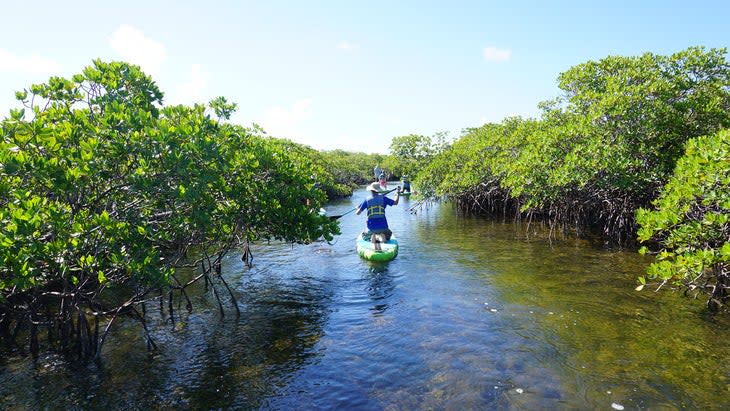
While still in Miami, hop on the daily paddle of Jones Lagoon, inside Biscayne Bay National Park, with the Biscayne National Park Institute. The half-day adventure has you paddling a SUP through narrow channels between mangroves looking for turtles and baby sharks in the shallow, clear water ($99 per person).
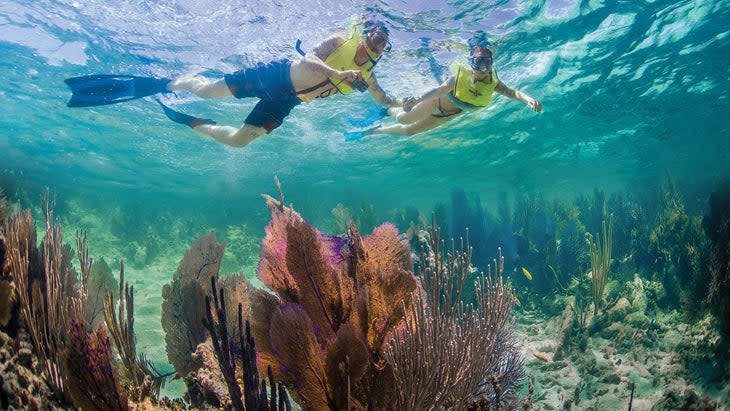
From the park, head south 70 miles on Highway 1 to Key Largo, where you can snorkel on Molasses Reef, inside the Florida Keys National Marine Sanctuary. The live barrier reef is several miles off the coast, but sits in just 10 feet of water, making it an ideal spot for viewing. Key Largo SCUBA Diving offers two afternoon trips to the reef daily ($70 per person).
Fuel up at the ElectrifyAmerica fast charging station at the Tradewinds shopping center in the middle of the island. Baker's Cay Resort has charging stations for guests, and its own private beach (from $412 a night).

Day Two: Key Largo to Key West
100 miles
Moving south through the Middle Keys, take time to kayak the half mile from Islamorada to Indian Key Historic State Park, an 11-acre island and park only accessible by small boat (entrance fee is $2.50 per person). Here you can hike through the ruins of a 19th-century town that existed solely to salvage items from ships run aground on nearby reefs, or paddle the healthy seagrass that surrounds the island.
Returning to the road, you can visit the Monroe County Public Library on Marathon Key, which has a free public Level 2 charger. Your next destination is Bahia Honda State Park ($8 parking fee), which has one of the prettiest beaches in the entire country. Then continue south to Key West, where you can rent a bike to cruise the eight-square-mile island (We Cycle rents bikes of all kinds from $14 a day), and hit Higgs Beach, a public beach lined with palm trees and easy, shallow-water snorkeling.
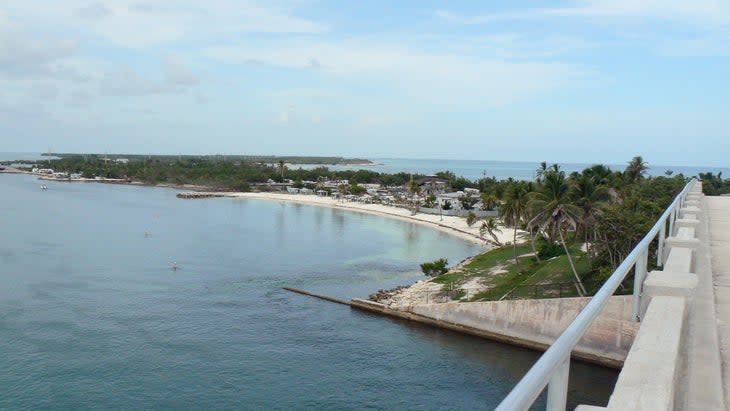
A number of hotels have slower Level 1 chargers that guests can plug into overnight, including the Opal Key Resort, which is located on the waterfront of Old Town Key West, putting you within walking distance of popular destinations like Mallory Square and Duval Street (from $360 a night). But there's also an ElectrifyAmerica ultra-fast charger at the Bank of America on Key West, so you'll be able to recharge wherever you stay.
3. The Perfect Western Road Trip: Denver to Moab
360 miles
This is one of my all-time favorite road trips. Even though the majority of this drive is on the much-maligned I-70, the pit stops along the way are bucket-list worthy, and the final destination is highlighted by two of the most stunning national parks in the West. The I-70 corridor, loaded with DC fast chargers established by a number of different companies, is one of the most EV-friendly roads in the Rockies.
Day One: Denver to Glenwood Springs
75 miles
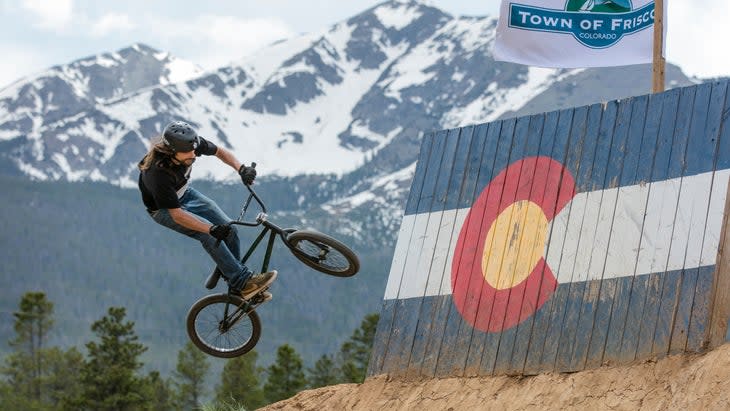
Get your junk miles out of the way as you head west on I-70 for 75 miles to Frisco, where your detours will be determined by the season. If it's winter, you're skiing at Breckenridge or Keystone. If you're here during summer or shoulder seasons, take your mountain bike for a spin in the Frisco Bike Park, which is free and has dedicated uphill and downhill trails designated by difficulty. The place has dirt jumps and a massive pump track, but don't overdo it: there's more mountain biking ahead.
Refuel at the DC fast charger at the Frisco Walmart, and drive past Vail (potential for fly fishing in the summer and powder in the winter) as you make your way to Glenwood Springs, where relaxation will be your priority.
Check out the Yampah Vapor Caves, which are essentially natural steam rooms, and consider getting a room at the Glenwood Springs Resort, so you can have immediate access to their hot springs-fed pool (from $199 a night). You have two options for refueling in Glenwood Springs, a ChargePoint fast charger at Starbucks or an ElectrifyAmerica at Target.
Day Two: Glenwood Springs to Palisade
75 miles
There are enough charging stations to get you all the way to Moab, but please--spend a day or so in Palisade, one of Colorado's hidden gems and one of my favorite towns. If you're here in ski season, Powderhorn Resort gets 250 inches of snow a year, on 600 acres. If it's bike weather, get a shuttle from Palisade Cycle and ride the 32-mile Palisade Plunge, a pedal-heavy downhill trail with plenty of technical bits and cliffy exposure (shuttle rides from $34 a person, available seasonally).
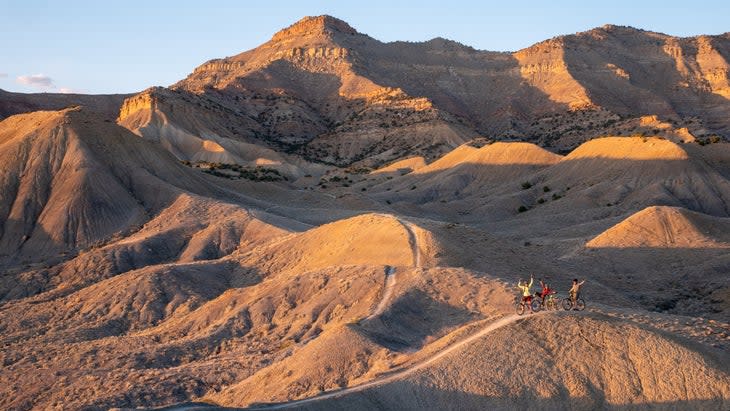
Day Three: Palisade to Moab, Utah
124 miles
There's a DC fast charger at the Stop n Save in Grand Junction, just west of Palisade that you should hit on your way out of town, but also a fast charger at the city offices in the town of Fruita, near the border of Utah. In the way that people have long known to fill up on gas here, charge up before heading out into the desert.
OK, now you're taking I-70 west to Highway 191 south into Moab, where you can choose from hiking in Arches National Park or Canyonlands National Park, or mountain biking in Dead Horse Point State Park. If I had to choose just one adventure, it would be the 7.6-mile traverse of the Devil's Garden area inside Arches, which also takes in the postcard-worthy Landscape Arch.
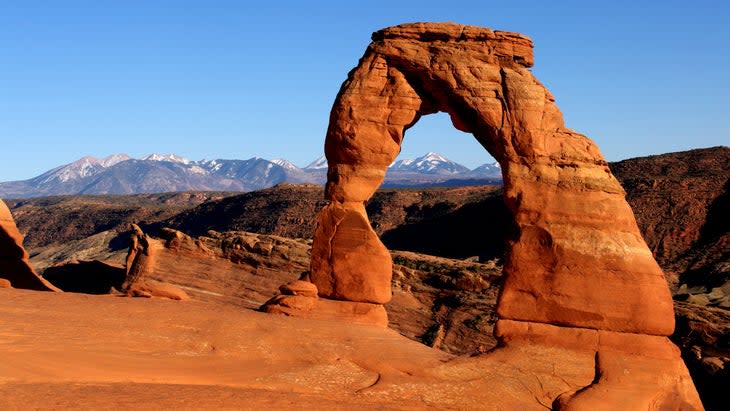
Get a room at The Hyatt Place, in Moab, which has a fast charger and an outdoor pool and hot tub. There's another charger for Teslas on Main Street. Be sure you charge your vehicle fully in town if you plan on exploring the desert, and keep an eye on your battery life, as there are currently no public chargers in the outlying areas.
4. The Vermont Ski Road Trip: Burlington to Killington
200 miles
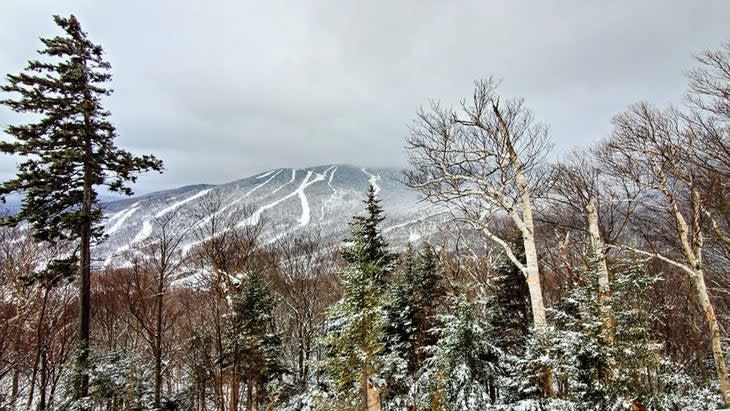
Cold will reduce your EV battery life by about 25 percent (in below-freezing temps), according to a study by Consumer Reports. That jumps to 50 percent if you're running the heater. The good news? This particular road trip is low on total mileage with super chargers along the way and chargers at each resort. Recharge while you ski!
Day One: Burlington to Jay Peak, 70 miles
The town of Burlington has 80 Level 2 chargers, including a handful of plugs at Burton Snowboards that are open to the public on weekends and weekday evenings. There's also a ChargePoint fast charger at Burlington's Electric Department. After fueling up, head north 70 miles to Jay Peak, only five miles south of the Canadian border, which enjoys some of the best snow east of the Rockies (more than 300 inches most seasons) over its 385 acres of terrain (lift ticket prices still TBD). The glades hold the best snow on this windy mountain. You'll find good tree runs off every lift, but Beaver Pond Glade has beautifully spaced trees with countless options for lines. Not into skiing? Jay Peak grooms more than 20 miles of fat-bike trails.
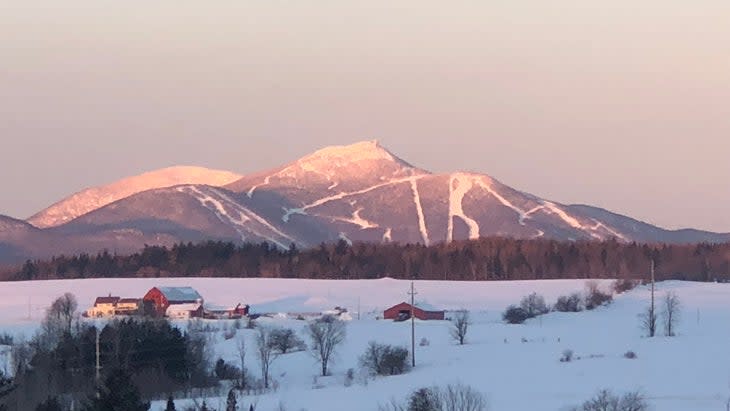
Jay Peak Resort has 14 Tesla chargers, and The Stateside Hotel at the base of the resort has Level 2 chargers as well as Tesla connectors (average rate is $400 a night).
Day Two: Jay Peak to Stowe Mountain Resort
Wake early and head an hour south (60 miles) to Stowe Mountain Resort, where almost 500 acres of skiable terrain is split across two mountains (lift tickets from $143 a day). The terrain is notoriously steep, with the famous Front Four trails (Goat, Liftline, National, and Starr) offering double-fall line, double-black pitches. For something less intimidating, check out Main Street, a long intermediate cruiser with views of the surrounding Green Mountains.
The Lodge at Spruce Peak has ski in/ski out digs (from $400 a night).
Stowe operates a handful of public chargers throughout the picturesque downtown, but you can also head straight to the Alchemist Brewery, and get some of the best IPAs in the Northeast while filling up at their DC Fast charger.
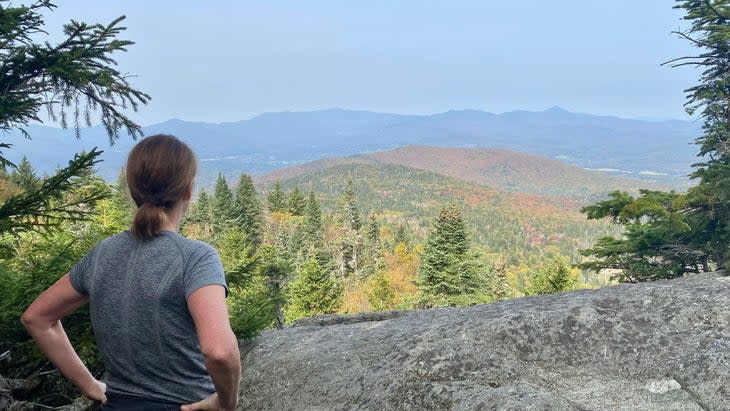
Day Three: Stowe to Killington
If you have an extra day, continue south for 85 miles to Killington Mountain Resort, but make sure you stop at the Ben and Jerry's Factory, in Waterbury, where you can get a scoop from this iconic ice-cream brand and recharge at their DC fast charger. Killington Resort itself has a full assortment of chargers throughout the base area, so again you can charge while you ski. As for the terrain, Killington, dubbed "the Beast of the East," has 1,500 acres to choose from. The most iconic line on the mountain is Outer Limits, which offers 1,200 vertical feet of bumps. Park rats should check out The Stash, a hidden park developed in partnership with Burton with features scattered throughout the trees.
5. The Classic California Road Trip: Pacific Coast Highway from San Francisco to Big Sur
150 miles
California has more than 73,000 public charging stations, roughly a third of all such stations in the country, so if you suffer from range anxiety, consider any road trip in the Golden State the perfect option. This particular route is a mega classic, following the Pacific Coast Highway from San Francisco to Big Sur, hitting state beaches and inland forests.
Day One: San Francisco to Santa Cruz
80 miles
As you head south from San Francisco, stop at Pacifica, a beachfront town with good surf, a walkable pier, and dramatic coastline. Get the lay of the land by exploring Mori Point, a 110-acre swath of beach and bluffs that is part of the Golden Gate National Recreation Area. You can peruse the black sand of Sharp Park Beach, or hike a two-mile loop through wildflower meadows that culminates with a bluff-top view of the Pacific.
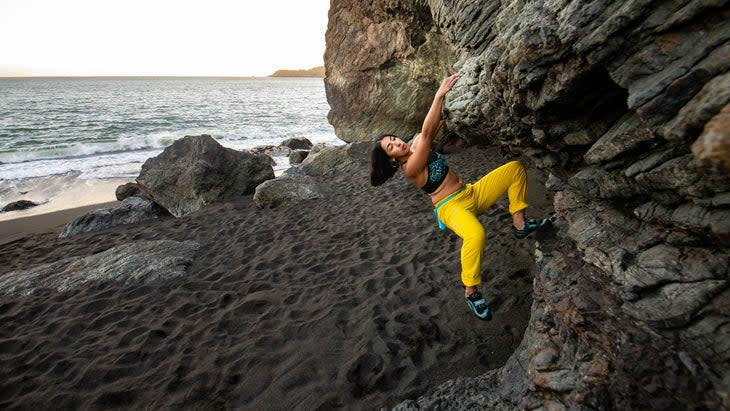
Your next stop is the town of Half Moon Bay, where you can watch big wave legends surf Mavericks Beach, and top off at the DC fast charger at the Bank of America on Main Street. As you move below Half Moon Bay, you'll pass a series of State Park-managed beaches, most with dramatic landscapes where the cliffs meet the water, so you can't go wrong with any detour. But Pescadero State Beach has a mile of soft sand, an ever-evolving collection of driftwood art, and a very cool rock bridge jutting out of the sand ($8 parking fee). If you want to spot some wildlife, Ano Nuevo State Reserve has a large population of breeding elephant seals that lounge on the beach during the winter ($10 entrance fee).
Hole up for the night in Santa Cruz, at Hotel Paradox, a funky but upscale inn in the center of town (from $156 a night) with an outdoor pool and fire pits. Charge your vehicle at the DC Fast Charger at the Whole Foods in the center of town.
Day Two: Santa Cruz to Big Sur
60 miles
If you're itching to surf, head to Cowell's Beach, a mellow break that's protected from big swells and has a laid-back vibe that makes it beginner friendly (Cowell's Surf Shop has rentals from $30 a day). After testing the waters, continue south on Highway 1, hugging the coast and, if you like, hitting Fort Ord Dunes State Park, which protects 1,000 acres of high dunes and pristine beach.
There are a couple of DC fast chargers as you approach Monterey, and an ElectrifyAmerica DC fast charger at the Target in Monterey proper. Juice up if you need to, and keep heading south toward Big Sur, with its awesome juxtaposition of cliffs, forest, and waves. You could spend a week in this nook of California and never get bored. Still, make time to explore Pfeiffer Beach, a day-use area in Los Padres National Forest ($15 entry fee) which has cliffs, natural bridges, and purple sand. No kidding.
There's no shortage of upscale digs in this lush corner of California, but it's hard to beat the location of Glen Oaks Big Sur, which has renovated motor lodge rooms or cabins (from $385 a night) and its own hiking trail through towering redwoods where you'll find swimming holes on the Big Sur River. EV drivers can also refuel overnight at the Level 1 charger at the lodge.
DC fast chargers are scarce in Big Sur (so are cell and internet service), but Tesla drivers can juice up at the Ventana Supercharger on the south end. And as long as you topped off in Monterey, you should have plenty of juice for the return trip north.
Keep in mind that road closures do pop up on Highway 1 in Big Sur because of rock slides. Check California's DOT page for current status.
6. A Stunning Pacific Coast Road Trip: The Southern Cascade Loop Scenic Highway
205 miles
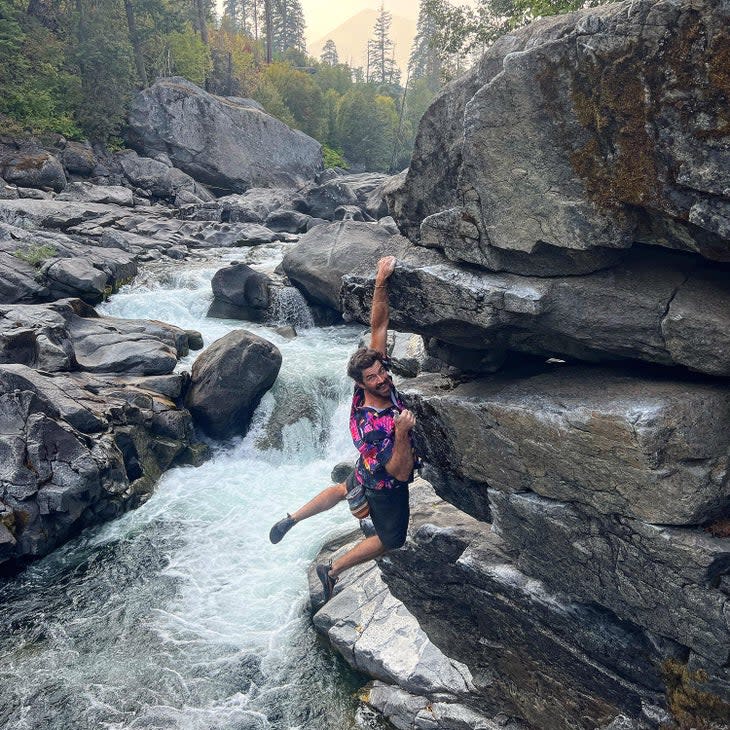
We've called the 440-mile Cascade Loop, which travels from the coast of Washington into the mountains and back, one of the prettiest drives in the country. It's also one of the most EV friendly, and has been for almost a decade, thanks to Washington State's emphasis on adding charging stations to its scenic byways. The northern portion of the highway is closed in the winter, but the southern part is open and awesome. You can see one itinerary in the link above, but below, we've detailed a 200-mile option along the southern corridor with winter in mind. Think: Bavarian villages and endless cross-country ski trails.
Day One: Everett to Leavenworth, 100 miles
Pick up the southern leg of the Cascade Loop in Everett, just north of Seattle, and take Highway 2 east towards Leavenworth. Follow the Skykomish River and climb 4,000 vertical feet to Stevens Pass Ski Area, an 1,125-acre resort that sits at the top of the Cascade Range and pulls down more than 450 inches of snow a year (lift tickets from $100). Advanced skiers should head straight for the 7th Heaven Chair and aim for the steep chutes that collect great powder and offer big bumps. Stevens Pass also offers the rare treat of night skiing.
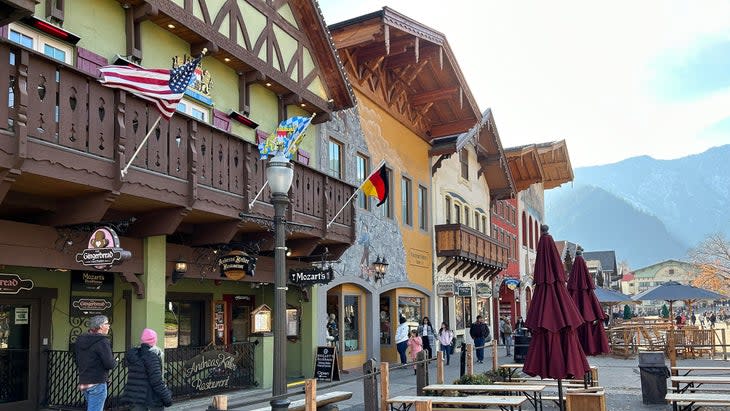
Then head further east to the town of Leavenworth, a Bavarian-themed village that goes all out in the winter; the entire town is decked out with holiday lights from Thanksgiving to Valentine's Day. The town also operates a small ski hill (named appropriately, "Ski Hill") with a tow rope and sledding run. In other seasons it is a center for hiking, boating, mountain biking, and climbing and bouldering.
There are a few DC fast chargers in Leavenworth, including one at City Hall and another at the Safeway grocery store. Grab a room at Loge, a budget-friendly adventure inn in the heart of downtown with its own beer garden (from $109 a night).
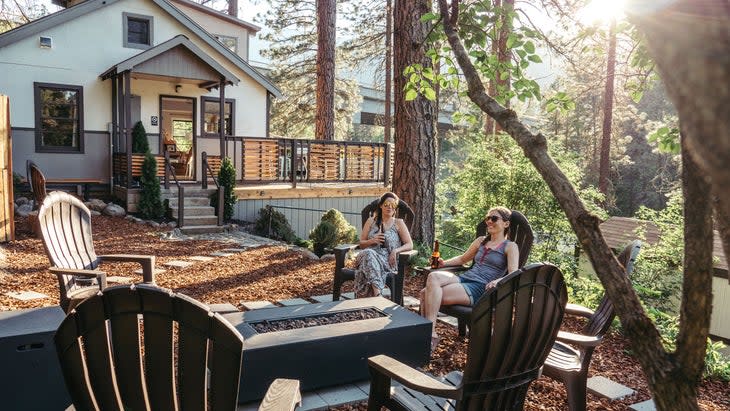
Day Two: Leavenworth to the Methow Valley
Head down the east side of Stevens Pass on Highway 2 and take Highway 97 north into the Lake Chelan Valley, where more than 30 wineries dot the shores of Lake Chelan. Drop into the family-owned Amos Rome Vineyard, where rows of grapes overlook the blue water of the lake and the tasting room is open daily. Show up in November and you can experience harvest season and taste wine straight from the barrel at certain events.
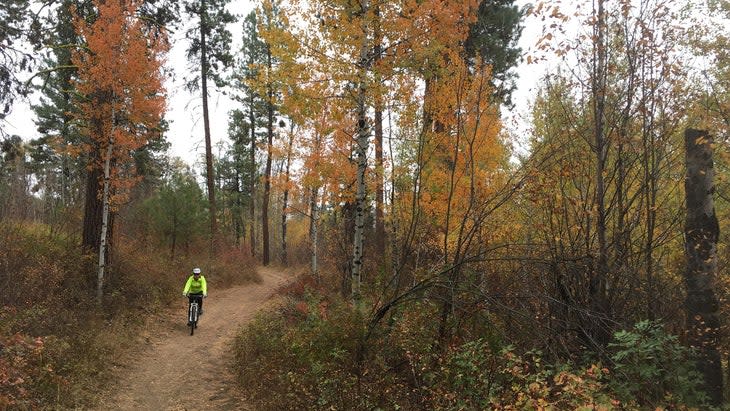
Continue north, taking Highway 153 directly into the heart of the Methow Valley, which boasts the largest network of groomed cross-country ski trails in the country. You'll have 130 miles of trails to choose from. Grab a day pass ($30, rentals ($30) and lessons (starting at $50) if you need them at Methow Valley Ski School.
Sun Mountain Lodge, in Winthrop, offers direct access to the Methow Valley Ski Trails, as well as 20km of trails on the property, and a charging ports for guests (from $207 a night).
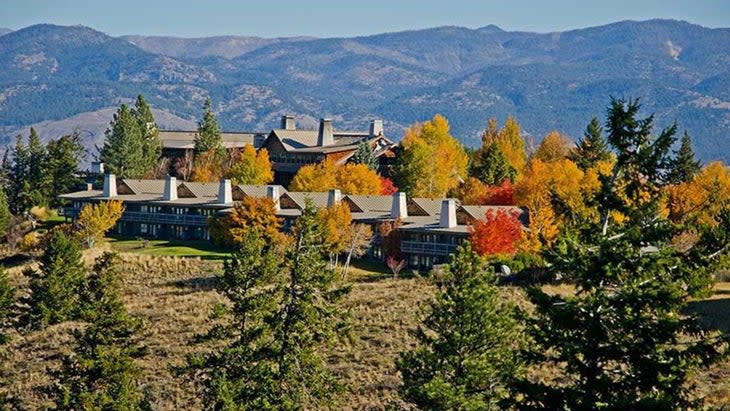
7. A Lake Michigan Road Trip: Traverse City to Manistee
150 miles
Michigan has one of the most robust charging infrastructures in the Midwest, increasing the number of chargers in the state by more than 200 percent in the last three years. Considering the car as we know it was born in Michigan, we appreciate seeing the state evolve with the tech. This road trip is short, but delivers, as it follows Highway 22 around Leelanau Peninsula, a skinny spit of land jutting out into Lake Michigan. There are cherries, lighthouses, beaches and dunes. Hit it now, before the snow hits, or wait until late spring. You'll begin and end in towns with DC fast chargers and have plenty of Level 2 options along the way.
Day One: Traverse City to Leland
60 miles
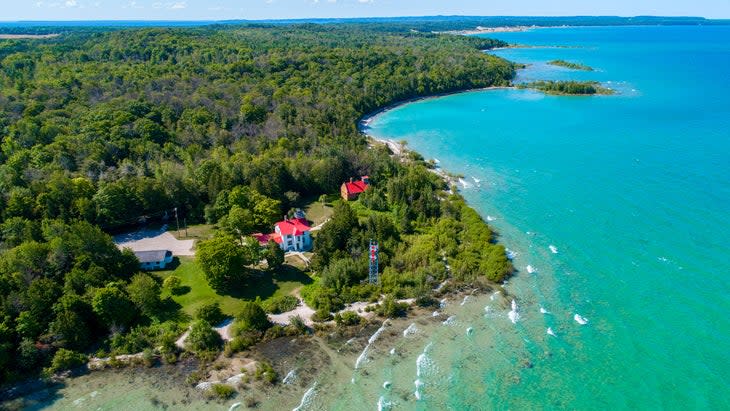
Juice up at the Hall Street Public Parking charger and head north on Highway 22 as it hugs the Grand Traverse Bay, offering countless views of Lake Michigan. When you hit Northport, head north of town to the tip of the peninsula to hike Leelanau State Park, on the edge of Cat Head Bay. One of the oldest lighthouses in the Great Lakes Area sits on the edge of the park, and you can hike the 4.6-mile Lake Michigan Loop, which will lead you by a small, interior lake and a sandy beach on Lake Michigan.
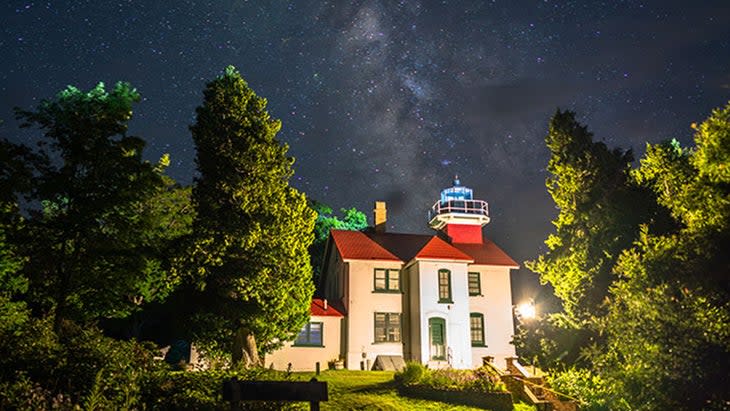
Moving south, take a pitstop at Hallstedt Homestead Cherries, a u-pick farm.
You'll pass Clay Cliffs Natural Area, which protects 1,700 acres of forest and sandy bluffs that's popular with nesting eagles, aiming for the small town of Leland, which sits on an isthmus between Lake Michigan and Lake Leelanau, home to "Fishtown," a collection of historic fishing shacks. It's a supremely walkable town with easy access to public beaches and boat launches. Falling Waters Lodge puts you in the heart of the action, with rooms overlooking the Leland Dam (from $179 a night). You can walk to Van's Beach to catch the sunset, then peruse town for some fish sausage. Yes, that's a thing.
Day Two: Leland to Manistee
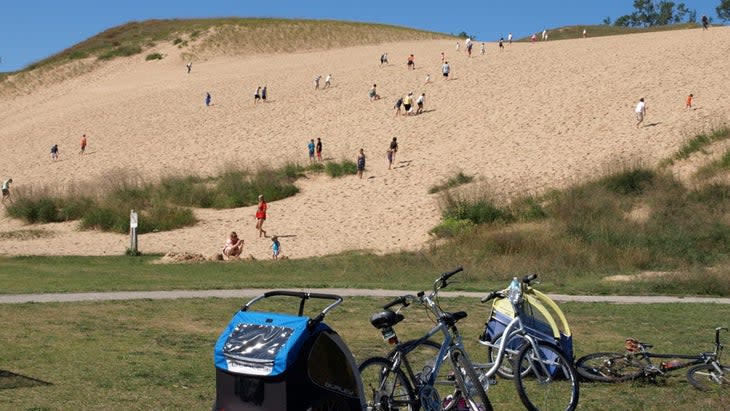
Continue south on Highway 22 and drive directly to Sleeping Bear Dunes National Lakeshore ($25 entrance fee per car), home to massive sand dunes that rise 450 feet above Lake Michigan. Spend some time here climbing the dunes (yes, it's allowed) and relaxing at the Platte River Point, where the river of the same name flows into the lake.
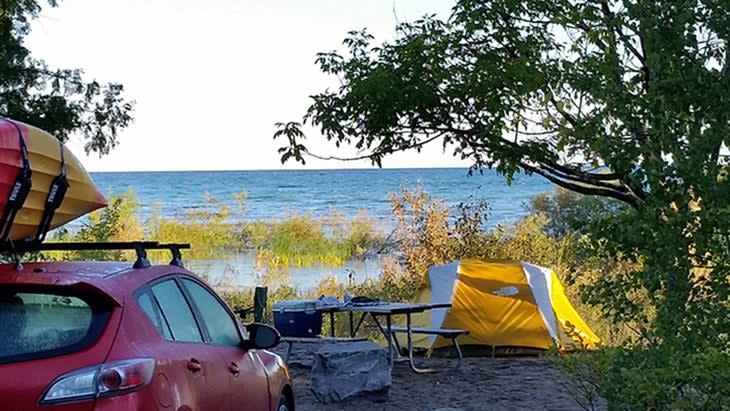
Heading further south, grab a beer at Stormcloud Brewing in Frankfort and end the day in Manistee, where you'll want to catch another sunset at Fifth Avenue Beach, and stroll the pier to the Manistee North Pierhead Lighthouse. The Hampton Inn, in Manistee, will put you on the water and it has a Level 2 charger for EVs (rooms from $171 a night). The Marathon Gas Station has a DC fast charger where you can refuel.
Graham Averill is Outside magazine's national parks columnist. He's been an avid road-tripper ever since becoming obsessed with the Beat poets as a teenager. An electric road trip is enticing to Graham because he likes the idea of taking a nap while his car charges mid-trip.
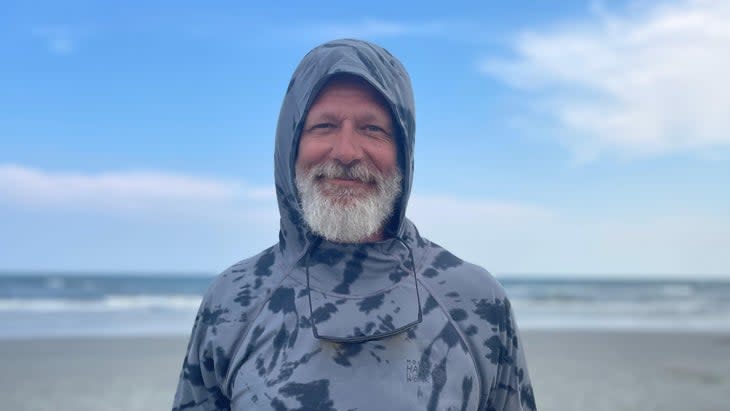
For exclusive access to all of our fitness, gear, adventure, and travel stories, plus discounts on trips, events, and gear, sign up for Outside+ today.

